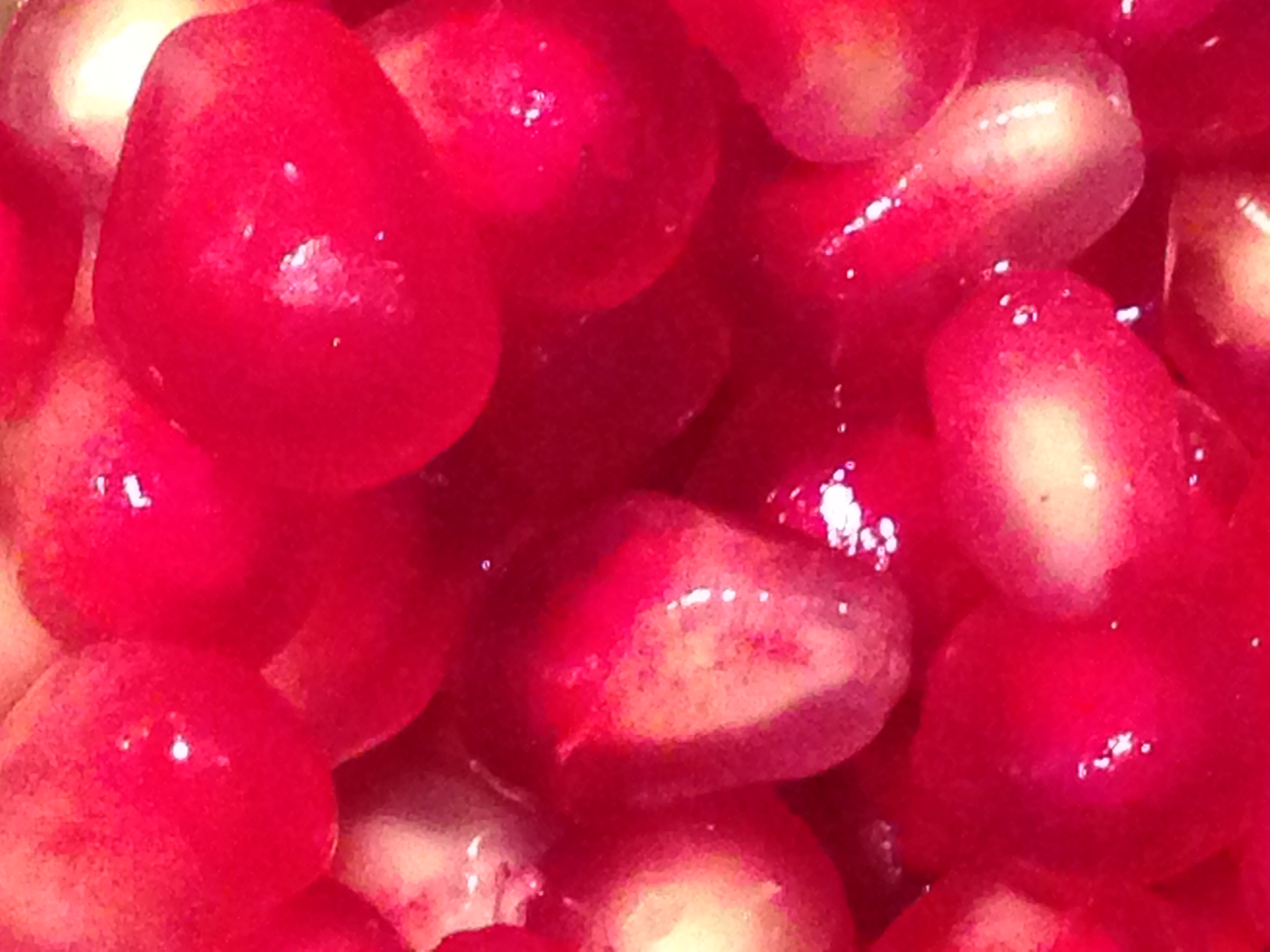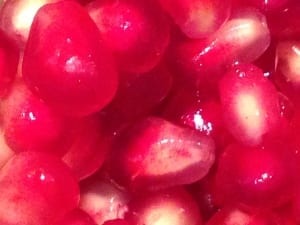Did you know that pomegranates are ancient? Let’s get up close and personal with the pomegranate, shall we? It’s one of the oldest fruits documented in history from as early as 4,000 B.C. The Latin meaning of the word is “seeded apple.” They have been depicted in stories, art, song, and used for dyes for thousands of years.
This large, hexagonal-shaped red fruit contains edible seeds, and only the seeds are edible. About 600 juicy seeds, also known as arils, encapsulate in a white pith within an average pomegranate. The pomegranate fruit is low in calories, high in fiber, high in vitamins and high in phytochemicals that may promote heart health and help to prevent cancer.
It’s also known as a super-food. So if it’s so super then why we don’t we eat more of them? We purchase them in ready-to-buy juice options at the convenience stores, but there’s something intriguing about buying them in the produce department. Honestly, I’ve passed them by on numerous occasions because I wasn’t sure about how to crack one open effectively and efficiently!
The problem with the pomegranate is that they are known for the difficulty in removing the edible seeds. You don’t have to use the complicated water method anymore. I mean, who has that kind of time? It’s way over due that we all get educated on how to enjoy the juicy seeds of the pomegranate.
If you walk through the produce aisle at your local grocery store you will see a whole bin of pomegranates waiting for you. I took a risk, bought one yet again this year and then researched how to open a pomegranate. So glad you are here today because I have searched high and low for the easy and simple solution to deseeding this yummy fruit and now you too can enjoy them by following these simple steps!
Step 1: Be adventurous, buy a pomegranate! You won’t be sorry for choosing this sweet, juicy treat!
Step 2: Once home, score the middle of the skin, like you are going to cut it half. But don’t cut it all the way through!
Step 3: Pull apart the two halves of the fruit. It should separate easily once you start, you will be empowered like a having girl powers or feeling like the hulk! Or, maybe that was my own little experience. Sometimes too much information is well…too much!
Step 4: Take each half and gently, with your hands, work the edges to loosen the seeds from the white pithy middle. This is not hard, I promise!
Step 5: Turn each half upside down over a bowl and beat with a wooden spoon. Hold the cut part of the pomegranate in the palm of one hand while beating with the other hand, holding a wooden spoon. You don’t have to buy any special equipment!
Step 6: Continue hitting the fruit with a wooden spoon until you feel tension in your upper arm, or bicep muscle. You’ll feel this right away!
Step 7: Continue to beat until all the seeds have popped out. I mean hard, like you are giving them a good spanking! It’s okay, they can take it!
Step 8: Repeat actions for the other half of pomegranate using the opposite arm for a balanced bicep workout. By eating this fruit you get a good arm workout too – you know I like that!
Step 9: Enjoy the fruits of your arm labor by eating the freshly popped seeds in your favorite recipe or just naturally with your fingers. (The seeds don’t stain like blueberries…the juice – yes. The seeds – no!) And they are fantastic on a green, leafy salad. (My favorite way to eat them.)
Step 10: Don’t fear the pomegranate. Their health benefits outweigh the higher calorie content. Pomegranates contain more calories per serving than several other fruits. Each 1-cup serving of pomegranate boosts your caloric intake by 144 calories, compared to 62 calories in an equivalent serving of blackberries, 87 calories in cherries or 52 calories in sliced apples. Pomegranates still provide a lower-calorie alternative to processed snacks or junk food.
If you don’t want to take my word for it or you want to see it before you believe it’s this easy, then watch this! http://www.youtube.com/watch?v=084ABt9q1n0
Other health facts about the pomegranate:
The seeds are rich in fiber, providing 4 g of dietary fiber per 100 g serving. A 100-g serving is equivalent to about 3/4 cup. According to the U.S. Department of Agriculture Dietary Guidelines for Americans, for optimal health with a 2000-calorie diet, you should consume 2 cups of fruit and 2½ cups of vegetables per day. Pomegranate seeds and other fiber-rich foods, such as whole grains, may reduce your risk of developing chronic disease. Also, it may aid in weight management.
Pomegranate seeds are a good source of two essential vitamins, C and K. A 100 g portion of raw, edible seeds provides 10.2 mg of vitamin C or 17 percent of the recommended daily value. It provides slightly more than 16 mcg of vitamin K, or 20 percent of the daily value, according to NutritionValue.org. Vitamin C aids in immune system function, wound healing, promotion of healthy gums, and the manufacture of collagen and elastin. It also enhances iron absorption. Vitamin K is important for maintaining strong, healthy bones as well as proper blood clotting. The seeds have anti-inflammatory, antiviral, and antimicrobial properties too.
Pomegranate seeds, like other fruits and vegetables, are rich in phytochemicals. Phytochemicals are beneficial substances found in quantities in plant foods. As powerful antioxidants, polyphenols may improve healthy cell survival, induce cancer cell death and prevent tumor growth, according to an article published in “The American Journal of Clinical Nutrition” in January 2005. On that note, it’s well worth adding to your diet often.




